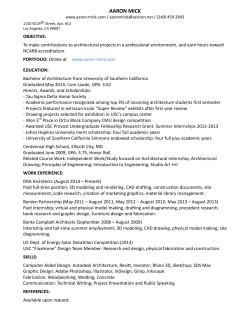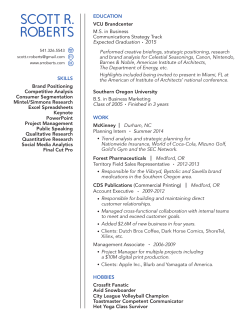
here - Form4 Architecture
COMMENT 30 The Architect’s Newspaper March 25, 2015 jeremy mende Comment> pierluigi Serraino and John Marx Our heads are spinning between bombastic statements about fantasies of mass-customization and the sadistic warping of unitized systems to adapt to predetermined forms, the wilder the better. Both camps operate without a working understanding of the role of emotional meaning in architecture. Emotional Meaning: The Intangible of Architecture SETTING THE STAGE Remember the last time you changed your route to stop and visit a particular building? You may have wanted to see it for some time; perhaps it was a curiosity or a tribute to your student days. Imagine you are there, entering the realm of its presence with all the particularities of your own life. That architecture is inevitable, substantive, impactful, consequential, and undeniably timeless. Still, in its beauty, the construction is a mute messenger of the larger order of things that you sense within, but are unable to declare. This artifact is the resonance chamber of all that is uncontainable within you. What you are seeing, occupying, savoring—in a word experiencing—is emotionally meaningful. We hold this to be a primary aspiration in the making of architecture. Emotional meaning aids in reconnecting the inner and outer dimensions of our world. When avant-garde modernists chose to prize reason over emotion, architecture detached itself from the world it was meant to improve. The cold rationality of performance and concept-based design left out the intangibles that make us human. Estrangement followed. Design without rigor inexorably turns capricious. On the other hand, design without heart lays out urban cemeteries. When rigor and heart are balanced, they infuse the CA/MW_03_24_32_SL.indd 8 city fabric with a sense of place. Bonding and belonging ensue. Emotional meaning in architecture occurs when the elements or the character of a space arouse an emotional response in the user that is meaningful, significant, and enduring. In an attempt to understand the structural relationship between architecture and people, can emotions be conceived as a cognitive basis for design rather than being hastily dismissed as personal opinions? It is within reason to say that few members of the public experience an emotional connection to today’s architecture. Design as problem solving often neglected this aspect, producing an ecosystem out of balance and fraught with undesirable consequences. The ascetic restraint of Miesian descent brought, and still brings, chilling austerity to the global urban imagery. Broadly speaking, current design tends to fall into two trends: sanitized glass-boxes rooted in a mid-century modern revival or Wild West formalism with fashionable architecture on stylistic overload. Either way, we are facing a particularly aggressive challenge on the emotional meaning front. Pervasive computing has enabled reckless self-indulgence from those architects married to innovation no matter what, whose formal language has imploded under the pressure of originality at all cost. WHERE WE WERE. WHERE WE ARE. The 20th century saw the hard sciences triumphant. Yet something went profoundly wrong. Calculus proved to be a defective instrument in solving the intractable problems pertaining to the broader human equation. Urban blight, one of the copious global scars of relentless industrialization, is the most discernible outcome of an engineering logic left unchecked. It is ubiquitous, inevitable, and of overwhelming magnitude. It stands as the deformed child of the unhappy union between mathematical reasoning operating on autopilot and design processes rooted in declarative procedures with no human insight. Obsession with problem solving, on material “honesty,” on the social overpowering the formal, and on the fetishizing of technology for technology’s sake has lead to the general public’s alienation from architecture. Thinking took over from feeling. The humanities got the short end of the stick. It would be all well and good if individuals were machines, but we know that to be untrue. Still we have yet to bear witness to a change in outlook. It is our contention that emotion links environments to their users and is fundamental to the architectural experience. Its role in architectural discourse is not just desirable, but necessary, as it would greatly expand the capacity of architects to symbolically reach the people they claim to design for. As buildings over time undergo changes in how they embody programmatic requirements, they remain vehicles for the renewal of emotional meaning. While a ubiquitous response, emotion’s specific realization is anything but universal. It differs in every person. The fact that two individuals can experience opposite emotional meaning in the same structure establishes a common ground between them even in the face of this polarity. Where did the resistance to emotions as a design factor come from? Terminology might have something to do with this discursive impasse. Some words, like beauty, can be so historically charged that their association with what are held as outmoded notions or past memories must be erased in the formative processes of new generations. Today we hear that customers have turned into “guests,” and employees are “dismissed” as opposed to being unceremoniously fired. What semantic transformations have “emotions” undergone in the patois of the highbrow crowd of the crowding the arena of our sedated perception: The Nostalgic: a sentimental longing for a past period, which is romanticized through the artistic artifacts of that era. The fallacy of nostalgia is that when the conditions that produced the artifacts no longer exist and the human condition has progressed from that point in time, this past loses its relevance and can no longer be credibly recreated. The Superficial: the cult of the physique. The superficial is still the focus of normative notions of beauty. Appearance over content is the quintessential antinomy of this ideal. Rather than being a popularity contest, architecture aims at longerterm values. The Commercial: unrestrained consumerism and transient gratification. When the primary purpose of the design of an object is to pander to the base instincts of a group in order to maximize sales, the end result is most often products that are shallow and short-lived. The Inauthentic: something that is not of its time; something that is untrue to the conditions and nature of its time, material, or technology; something that appears to be what it is not. Emotional meaning alone is not the basis of design; but its absence renders architecture without merit. It is the inscrutable raison d’être that links the act of building to the sublimation of the inner self; a mixture of pleasure, bliss, and rootedness. The physiology of the body starts registering the presence of an artifact designed with intent to go beyond the circumstantial practicalities of the program. It is A WAY FORWARD intelligible in its nuanced aspirations, Emotional meaning supplies while providing the bond to hold the architects with the capacity to personal blocks that form the whole discern the priceless against the of humanity. Emotional meaning dispensable. Bringing it back into stirs catharsis to the collective and the broader dialog is especially that unfathomable togetherness useful given how participatory that resets individuals’ unwavering design has taken renewed hold as commitment to kinship. This is we go deep into the 21st century. territory foreign to rational planning, Finally, the faceless stakeholders the quicksand of engineering analysis. get their seat at the design table This reflection is presented to sharing the entries until now in jumpstart a conversation within the the hands of financial and program architecture community. In weaving driven clients. Emotional meaning emotions back into the evaluation will add its weight into the balance criteria, we are advocating for a mix to cater long-term to the disciplined practice of design where community in factual ways. the metaphysical layer that always Emotional Meaning matters now existed in architecture, whether in for the following reasons: religious or secular centuries, can find It helps to re-establish the an explicit and sustainable resolution general public’s trust and affection into a material arrangement toward architects. that speaks to the concerns and It constitutes an opportunity to emotional bandwidth of 21st century inhabitants. In pursuing a much reengage clients to the value of tighter fit than ever before between architecture. form and emotion, architects can It resets the architect’s outlook to design with people and art as in once again exercise their capacity to dissoluble essentials of architecture. steer society toward the realization of their current understanding of Ever cognizant of the failures of the past—like the use of emotions citizenship, well-being, and healthy participation of community members for the opportunistic to legitimize into the public realm. their designs and populate the environment with the unsightly— John Marx and Pierluigi Serraino a starting list would include the are authors and architects who following four offenders, guilty of live in the Bay Area. past 40 years? Given the secular nature of 20th century culture and beyond, emotions are perilously evocative of faded romanticism, signposts of irrelevant concerns to what today’s gatekeepers of architectural discourse deem to be currency. They dispose of emotions as annoying, sentimental yearnings unsuitable to the blueprint of cultural and societal reformation that the promoters of modern and postmodern architecture have endorsed. Our critics offer an array of alternative idioms to talk effectively about the same notion. A glaring example is the tragic anonymity of Silicon Valley. As visitors, we cannot help wondering what the root cause is for the inverse relationship between unparalleled financial wealth and the deterioration of the urban condition in the same territory. Design platitude is all around us. It is the malaise of our time and exclusively of our own making. Form-making by itself is an empty exercise, negating the qualitative function of architecture in human existence. Self-expression, on the other hand, is the filtering of circumstances and contingency through the sensibility of an individual, resonating with the socio-physical character of the site. Rationality alone cannot resolve the conflicts between these two seemingly opposite points of view. Hyper-focus on the physical metrics of the human body, e.g. design based on human scale handbooks, or equation-based design, e.g. parametric architecture, are likely shortcuts to a space of collective alienation. 3/17/15 4:11 PM
© Copyright 2025





















